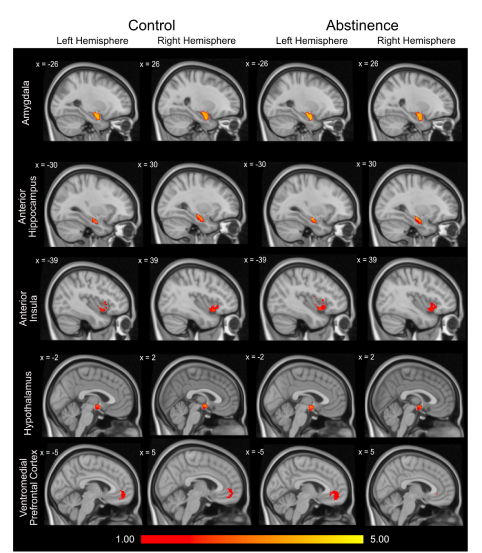THE IDEA
A novel neuroimaging study provides the first evidence that a small region of the brain, called the bed nucleus of the stria terminalis, has gender-based network structural connectivity differences in early abstinence from alcohol. Through the brain-imaging technique Diffusion Tensor Imaging, the researchers used 3D modeling to identify the structural nerve tract connections of the BNST, which regulates stress responses and anxiety-like behaviors during abstinence from alcohol. This is the first time that BNST structural networks in early abstinence have been studied in humans.

The key finding was that women in the abstinence group showed stronger overall BNST network structural connectivity compared with women in the control group, a difference that was not seen in men. Women also showed differences compared with men in the strength of BNST structural connections to two specific brain regions. These results expand on previous findings of sex differences of the BNST in alcohol use disorder and in abstinence—including that women are more likely than men to relapse as result of anxiety symptoms.
WHY IT MATTERS
“Our study initially was focused on studying BNST networks in early abstinence. But we discovered a robust sex difference, that suggested the alterations were stronger in women. This was very exciting because there is increasing awareness that alcohol use disorder impacts women worse than men,” said Jennifer Blackford, Vanderbilt Center for Addiction Research faculty affiliate and professor of psychiatry and behavior sciences, and psychology.
Women in early abstinence from alcohol use disorder show important alterations in brain connectivity that could underlie anxiety-induced relapse. Long-term recovery from AUD is challenging, particularly through periods of stress or uncertainty. In the early abstinence phase, the anxiety symptoms can be temporarily relieved by alcohol, creating a powerful motivation to resume drinking. Thus, understanding the neural changes of abstinence-related anxiety is critical for understanding, and ultimately preventing, AUD relapse.
WHAT’S NEXT


Blackford and Danny Winder, VCAR director and Bixler-Johnson-Mayes Professor of Molecular Physiology and Biophysics, Pharmacology, and Psychiatry, have received an R01 grant to continue research on sex differences of the BNST circuit that may improve understanding and treatment options.
FUNDING
This work was funded by Vanderbilt Institute for Clinical and Translational Research grant VR54926, National Institute of Mental Health grant T32MH018921, National Institute on Alcohol Abuse and Alcoholism grants F30AA027418 and R21AA025385, and National Institute of General Medical Sciences grant T32GM007347.
GO DEEPER

The article, “Alterations in connectivity of the bed nucleus of the stria terminalis during early abstinence in individuals with alcohol use disorder,” was published in the journal Alcoholism: Clinical & Experimental Research on April 8. It was selected as an Article of Public Interest, as it is one of the journal’s most interesting alcohol-related research publications.
Lizzie Flook, a neuroscience student and trainee within the Vanderbilt Medical Scientist Training Program participated in the research. The MSTP prepares students for faculty and research positions of leadership in the biomedical sciences, integrating core education in medicine and intensive training in scientific inquiry. Successful completion of the program leads to both the M.D. and Ph.D. degrees.